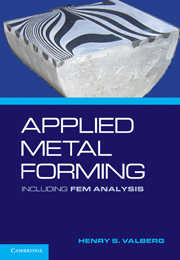Book contents
- Frontmatter
- Contents
- Preface
- APPLIED METAL FORMING
- 1 Characteristics of Metal Forming
- 2 Important Metal Forming Processes
- 3 FEA of Metal Forming
- 4 Theory
- 5 Reduction and Proportions of the Plastic Zone
- 6 Deformations from the Velocity Field
- 7 Technological Tests and Physical Simulation
- 8 Flow Stress Data
- 9 Formability and Workability
- 10 Friction and Friction Models
- 11 Thermal Effects
- 12 Experimental Metal Flow Analysis
- 13 Theoretical Methods of Analysis
- 14 Finite Element Analysis
- 15 FEA of Technological Tests
- 16 Forging
- 17 FEA of Forging
- 18 Extrusion
- 19 FEA of Extrusion
- 20 Rolling
- 21 FEA of Rolling
- 22 Drawing of Wire, Profiles, and Tubes
- 23 FEA of Wiredrawing
- 24 Sheet-Metal Forming
- Index
- References
3 - FEA of Metal Forming
Published online by Cambridge University Press: 05 June 2012
- Frontmatter
- Contents
- Preface
- APPLIED METAL FORMING
- 1 Characteristics of Metal Forming
- 2 Important Metal Forming Processes
- 3 FEA of Metal Forming
- 4 Theory
- 5 Reduction and Proportions of the Plastic Zone
- 6 Deformations from the Velocity Field
- 7 Technological Tests and Physical Simulation
- 8 Flow Stress Data
- 9 Formability and Workability
- 10 Friction and Friction Models
- 11 Thermal Effects
- 12 Experimental Metal Flow Analysis
- 13 Theoretical Methods of Analysis
- 14 Finite Element Analysis
- 15 FEA of Technological Tests
- 16 Forging
- 17 FEA of Forging
- 18 Extrusion
- 19 FEA of Extrusion
- 20 Rolling
- 21 FEA of Rolling
- 22 Drawing of Wire, Profiles, and Tubes
- 23 FEA of Wiredrawing
- 24 Sheet-Metal Forming
- Index
- References
Summary
Finite element analysis (FEA) has been developed during the last decades as a very useful tool for analysis of metal forming processes. Progress in development of cheap and efficient computer technology, and the implementation of the finite element method (FEM) into user-friendly, window-based programs, has brought this technology forward. One can state that this development has more or less revolutionized the art of metal forming analysis.
In this chapter, it is demonstrated how 3D FEA can be applied for the analysis of a particular metal forming operation, namely, plane strain compression. To show how well such analysis describes the actual conditions in metal forming, it is used to model and to reproduce a series of experiments conducted on an aluminum alloy in the laboratory. In the experiments, an advanced grid pattern technique was used to characterize the real metal flow occurring in this deformation process.
The Plane Strain Compression Test
The plane strain compression test is conducted as either a cold- or a hot-forming test. Although thermal effects are generally negligible in cold forming, they are important in hot forming. So to gain good accuracy, thermal effects must be included in hot-forming models. The flow stress of the workpiece material is an important parameter used in the FEM model. This parameter is very different in cold and in hot forming, as discussed in Ch. 8. Whereas flow stress is not significantly influenced by temperature in cold forming, in hot forming it depends strongly on temperature.
- Type
- Chapter
- Information
- Applied Metal FormingIncluding FEM Analysis, pp. 34 - 52Publisher: Cambridge University PressPrint publication year: 2010
References
- 1
- Cited by



